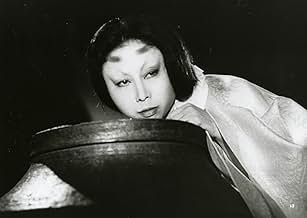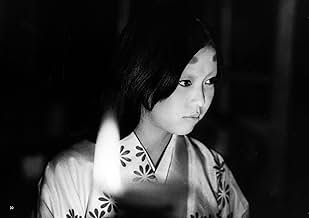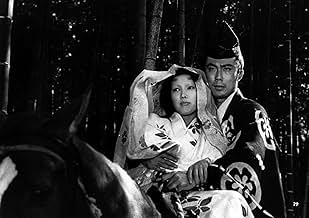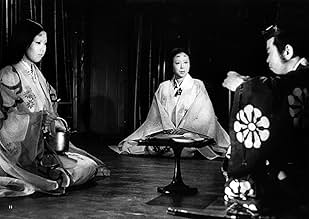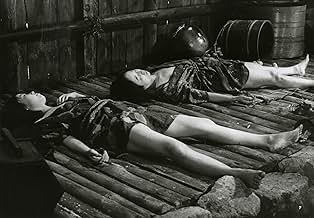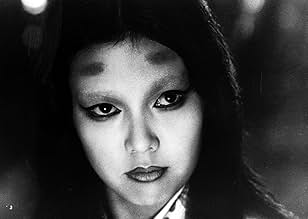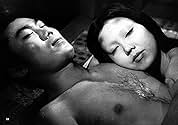IMDb-BEWERTUNG
7,7/10
9440
IHRE BEWERTUNG
Füge eine Handlung in deiner Sprache hinzuTwo women are raped and killed by samurai soldiers. Soon they reappear as vengeful ghosts who seduce and brutally murder the passing samurai.Two women are raped and killed by samurai soldiers. Soon they reappear as vengeful ghosts who seduce and brutally murder the passing samurai.Two women are raped and killed by samurai soldiers. Soon they reappear as vengeful ghosts who seduce and brutally murder the passing samurai.
- Auszeichnungen
- 2 wins total
Empfohlene Bewertungen
While watching 'Kuroneko,' I must admit I was a little distracted by what were, to me, anyway, stylistic issues: The beautiful black-and-white photography was so vivid and made clear so many little details, in contrast to which the story and the action was delivered in broad, stylized strokes. Something about this didn't work for me - the image, somehow, was too unforgiving on the simply conceived story...not to mention the makeup effects. When a shot of thrillingly real roaring fire at the opening is followed by a shot of the burned bodies, two actresses with, essentially, charcoal rubbed on parts of their arms and legs, and lumpy fake blood spread on their throats...well, it hurt my ability to get into the world of the movie. As did sequences of the plot where the characters' actions didn't follow normal human psychology ("But if he recognized her, wouldn't he say something?") If the image hadn't been so vivid I wouldn't have had to keep thinking of them as actors in a stilted, stylized script. But I did. So sue me. Maybe that's culture clash - maybe the dramatic stylization is direct from the Japanese tradition and would have felt natural in its own way to someone from Japan. Well. I'm not Japanese.
But the important thing here is that, while the movie's horror, while I was watching it, was negligible because of all the above...in the days following, I found myself more and more haunted by some of the truly eerie imagery and the undertones of the plot. To return home, having become a man, and find that your family has turned to demons - demons who might sometimes, partially, still be your family, but will never talk about it...there are shadows of a powerful nightmare in there.
The fight sequence in the rushes, and the slow processions through the bamboo grove, in particular, reverberate in my mind. These scenes, among others, were well supported by the excellent musical score.
I don't know what to make of the last few scenes - the movie had spent itself several times over by that point, though, and in a sense, the exact twists and turns of the plot were only of secondary importance. Watch it for its uniquely eerie atmosphere (and lovely photography), and then enjoy as it slowly settles in to your subconscious.
But the important thing here is that, while the movie's horror, while I was watching it, was negligible because of all the above...in the days following, I found myself more and more haunted by some of the truly eerie imagery and the undertones of the plot. To return home, having become a man, and find that your family has turned to demons - demons who might sometimes, partially, still be your family, but will never talk about it...there are shadows of a powerful nightmare in there.
The fight sequence in the rushes, and the slow processions through the bamboo grove, in particular, reverberate in my mind. These scenes, among others, were well supported by the excellent musical score.
I don't know what to make of the last few scenes - the movie had spent itself several times over by that point, though, and in a sense, the exact twists and turns of the plot were only of secondary importance. Watch it for its uniquely eerie atmosphere (and lovely photography), and then enjoy as it slowly settles in to your subconscious.
Today I want to talk about Kuroneko (The Black cat in english). For anybody who doesn't know about this Japanese classic, I want to say: what? Are you crazy? I'm just kidding, but seriously you cannot miss this incredible film. It tells you so much about Japanese culture and cinema. Kuroneko is written and directed by one of my fav Japanese directors: Kaneto Shindo. I know, he's not as famous as Kurosawa nor Ozu, but he's brilliant nonetheless. He's the mind behind Hachikô Monogatari, Hatchi with Richard Gere is the US remake of this touching picture. In his career, Shindo has written almost 200 films and has directed near 50 films. Unfortunately, he died a few years ago, at the age of a 100 years old. Kuroneko is a Japanese kaibyo eiga, it's the ghost cat film genre in japan, very popular and prolific during the 60's. It includes ghosts, murder and a black cat figure. Kuroneko is an avant-gardist horror film, ahead of his time, it's also very provocative, because it involves gang-rape and murder. It's eerie, atmospheric, scary, romantic, sad, and beautiful. The cinematography is simply amazing, every frame is like a painting. Kuroneko is definitely one of my all-time favorites. I urge you to watch it.
Director Kaneto Shindô is most famous for his 1964 ghost story Onibaba; and anyone that enjoyed that film will certainly enjoy this one. The two films are very similar in style, and that's a good thing for both as the thick and surreal atmosphere created by the director creates a perfect atmosphere for a horror story to take place in. The title of the film translates in English to 'The Black Cat' - a staple of the horror genre ever since Edgar Allen Poe penned his classic story; although this film has nothing to do with the writings of Poe and is an original story written by the director. The film takes place in feudal Japan and our focus is on a mother and daughter-in-law living alone in the swamp. Its war time and all the samurais are out fighting. However, one day a group of them happen on the pair and after eating their food, the samurai's rape the women. Shortly thereafter, many samurai are being found dead in the area; they are drained of blood with their throats ripped out. Naturally the lord of the land comes to the conclusion that a monster is behind it, and sends a young hero to deal with the problem.
Kaneto Shindô is keen to fill his film with rich symbolism and striking visuals; but also finds time for some visceral horror. The opening scenes are shocking and later the films builds into some truly memorable and surreal sequences that, when combined with the atmosphere, do manage to be quite frightening. The swamp location is a really great place for the film to take place also; and the director makes the best of it, especially during the parts in which the younger of the two women is leading the stray samurai's to their death. The film is more than just the central story; and we also follow things going on around it; such as the eventual hero's fight that earned him the right to seek out and kill the demons. The central story is definitely the most interesting, however, and while the sub plots are not boring; I did mostly find myself waiting for the film to get back on track. The way that the story builds into the end, which really brings all the stray subplots together, is really good and the film ends on a very strong note. Overall, The Black Cat is not quite as great as the director's masterpiece Onibaba; but it's certainly a very good horror film.
Kaneto Shindô is keen to fill his film with rich symbolism and striking visuals; but also finds time for some visceral horror. The opening scenes are shocking and later the films builds into some truly memorable and surreal sequences that, when combined with the atmosphere, do manage to be quite frightening. The swamp location is a really great place for the film to take place also; and the director makes the best of it, especially during the parts in which the younger of the two women is leading the stray samurai's to their death. The film is more than just the central story; and we also follow things going on around it; such as the eventual hero's fight that earned him the right to seek out and kill the demons. The central story is definitely the most interesting, however, and while the sub plots are not boring; I did mostly find myself waiting for the film to get back on track. The way that the story builds into the end, which really brings all the stray subplots together, is really good and the film ends on a very strong note. Overall, The Black Cat is not quite as great as the director's masterpiece Onibaba; but it's certainly a very good horror film.
Shot in black and white, this film has some unique imagery to accompany the creepy haunting.
Very much in the style of Kwaidan and other Japanese supernatural films of the 1960's. And very much a traditional Japanese ghost story where ghosts and evil spirits inhabit a world of logic alien to the real world. Western ghosts stories usually have the spirits think as living people do. Japanese spirits behave in bizarre ways that are much more disturbing.
The film follows the two spirits of a murdered wife and mother-in-law as they proceed to kill and drink the blood of any samurai that passes their neighborhood. The film, while very well made, is slightly routine at this point. When the husband returns a war hero, the film becomes poetic as he is assigned the task of eliminating the "monster" that is killing samurai. His encounters with his now demonic wife and mother comprise the rest of the film.
A truly excellent film. Any fan of the new Japanese horror films should see where they come from.
Very much in the style of Kwaidan and other Japanese supernatural films of the 1960's. And very much a traditional Japanese ghost story where ghosts and evil spirits inhabit a world of logic alien to the real world. Western ghosts stories usually have the spirits think as living people do. Japanese spirits behave in bizarre ways that are much more disturbing.
The film follows the two spirits of a murdered wife and mother-in-law as they proceed to kill and drink the blood of any samurai that passes their neighborhood. The film, while very well made, is slightly routine at this point. When the husband returns a war hero, the film becomes poetic as he is assigned the task of eliminating the "monster" that is killing samurai. His encounters with his now demonic wife and mother comprise the rest of the film.
A truly excellent film. Any fan of the new Japanese horror films should see where they come from.
First of all, I would LOVE to know why this classic of Japanese 60's cinema is NOT in VHS or better yet, DVD, format in Region 1 format???
It's a real shame, as it is a perfect pairing with Onibaba(which was a terrifying double bill in San Francisco in 1978, thereabouts). It explores the touchy subject of revenge, revenge for terrible deeds done to the women, and how perfectly they exact their revenge from the grave. Guaranteed you will never hear the rustling sounds of bamboo ever the same again.
This is a movie for adults, as the subject matter is intense. It is an indictment of how women were and are treated in warfare, and the horrifying toll it takes on everyone.
I highly recommend this film. If you can locate it-for some odd reason it is extremely hard to get, and it deserves a much wider audience.
It's a real shame, as it is a perfect pairing with Onibaba(which was a terrifying double bill in San Francisco in 1978, thereabouts). It explores the touchy subject of revenge, revenge for terrible deeds done to the women, and how perfectly they exact their revenge from the grave. Guaranteed you will never hear the rustling sounds of bamboo ever the same again.
This is a movie for adults, as the subject matter is intense. It is an indictment of how women were and are treated in warfare, and the horrifying toll it takes on everyone.
I highly recommend this film. If you can locate it-for some odd reason it is extremely hard to get, and it deserves a much wider audience.
Wusstest du schon
- WissenswertesThe movie was placed in competition at the 1968 Cannes Film Festival, but the festival was canceled due to the civil unrest events of May 1968 in France.
- PatzerWhen the cat crawls over the bodies after the fire, the mother can be seen to breathe.
- VerbindungenFeatured in Ebert Presents: At the Movies: Folge #2.15 (2011)
Top-Auswahl
Melde dich zum Bewerten an und greife auf die Watchlist für personalisierte Empfehlungen zu.
- How long is Black Cat?Powered by Alexa
Details
- Erscheinungsdatum
- Herkunftsland
- Sprache
- Auch bekannt als
- Kuroneko, el grito del sexo
- Produktionsfirma
- Weitere beteiligte Unternehmen bei IMDbPro anzeigen
- Laufzeit
- 1 Std. 39 Min.(99 min)
- Farbe
- Seitenverhältnis
- 2.35 : 1
Zu dieser Seite beitragen
Bearbeitung vorschlagen oder fehlenden Inhalt hinzufügen


